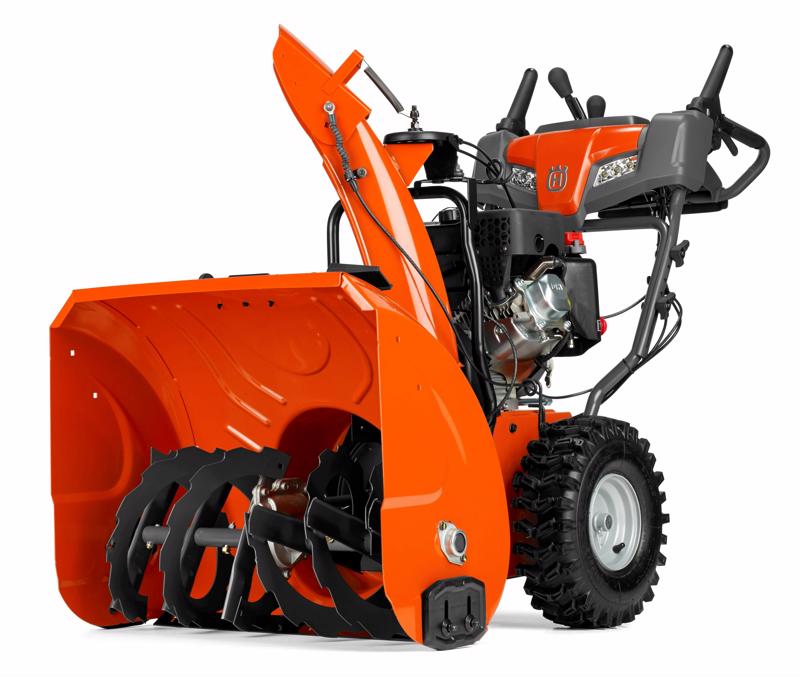If you had the foresight to buy a Husqvarna snow blower at the start of winter, odds are you’re feeling good about your purchase now. After several months of blistering cold and driving snow, you might even wonder how you would’ve made it through the winter without your trusty single- or two-stage snow blower at your side.
But there comes a time in every tool’s life when it needs to be put away for the season. When the February snow starts to turn into March rain, you need to think about preparing your snow blower for a well-deserved offseason. However, putting the snow blower in the garage in between storms is much different than shutting it down for an entire summer. If you want your top-of-the-line Husqvarna snow blower to look good as new when you need it next winter, follow these five steps to store it properly during the offseason.
 What does it take to get this from mid-winter form to offseason storage?
What does it take to get this from mid-winter form to offseason storage?1. Down the drain
Fuel can be expensive, and if Mother Nature made you use a lot of it this winter, you’re probably loath to let it waste away in your snow blower all summer. That’s why dealing with your fuel tank should be your first task when preparing your snow blower for long-term storage.
The simplest option is to drain the fuel tank. Leaving any amount of untreated fuel in your machine can cause your engine to seize up when the active elements inside the liquid decay. You could leave it in, but only if you add a long-duration stabilizer to the mix – this will keep the fuel from breaking down and harming your machine while it waits for winter to return.
2. Spark a connection
The unsung hero of every machine with an internal combustion engine is the spark plug. This little guy is responsible for igniting fuel to make everything from pistons to gears move, but by the end of winter, the spark plug in your snow blower is more than likely overworked and burnt out.
That’s why it’s highly recommended that you swap out spark plugs when storing your snow removal machine for the summer. Even if you just bought a new one, don’t insert it into the engine until winter – leaving the spark plug in place could cause corrosion and sap the device of its power.
3. Bolt it, wrench it, screw it
The more powerful the engine in your snow blower, the more force it exerts. On the one hand, your snow removal machine needs plenty of power to turn the augur and cut through sheets of ice and snow. However, the same force that allows it to tackle even the toughest blizzards also means that you’ll have to give your snow blower a once-over with a wrench at the end of the season.
While snow and ice can dislodge some pieces, the regular vibrations and use of snow blowers will naturally loosen some nuts, bolts and other fasteners around the machine’s chassis. While it’s unlikely that these will shoot off into the air like a cartoon while you’re using your machine, they can lead to decreased performance as the months wear on. Take a few minutes as you’re preparing your blower for storage to check for any loose fasteners and tighten them up before putting your machine away.
“Pick a spot indoors with limited exposure to dirt and dust.”
4. Storage wars
After you’ve spent an hour clearing your property during the heart of a Nor’easter, the last thing you want to worry about is where you’re going to store your blower. However, when it comes to putting the device away for several months, location is everything.
Try to pick a spot indoors with limited exposure to dirt and dust. While these might seem like child’s play compared to what your snow blower faces in the winter, long periods of disuse can make your blower more susceptible to damage from particulate matter. Keep your snow removal machine in a well-ventilated area for best results the following winter.
5. Stock up for snow
The sun is shining, the birds are chirping and your kids are home on summer vacation. Even though you might be in a sunny state of mind, you still need to keep your focus on next winter – and that includes stocking up on all the spare parts you’re likely to need when the snow storms return.
Check your machine for broken shear pins, worn fan or drive belts and frayed pull cords. Buying these now will help you avoid the rush in early fall when your neighbors realize winter is coming. Also, retailers may offer lower prices in non-peak months, so shopping early for spare parts could land you some unexpected savings as well.